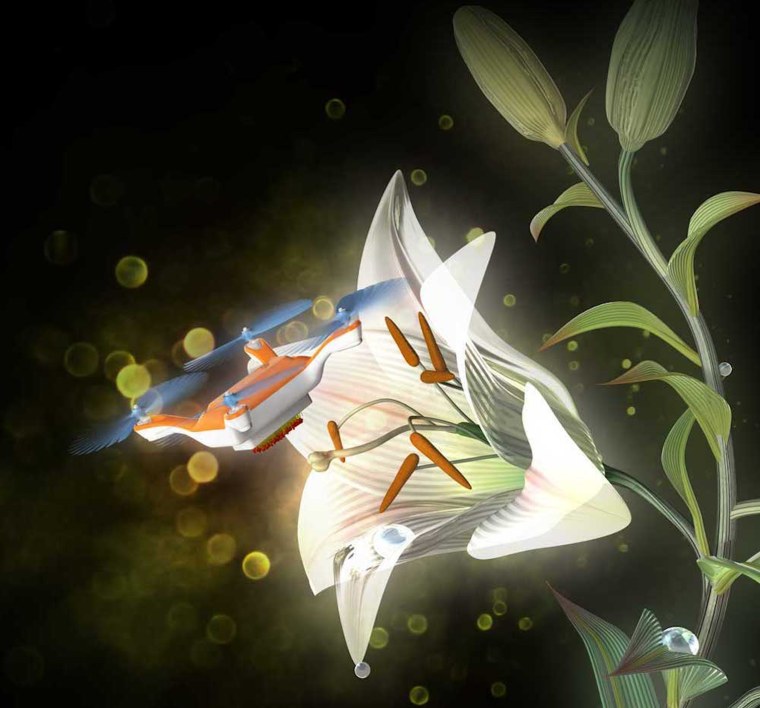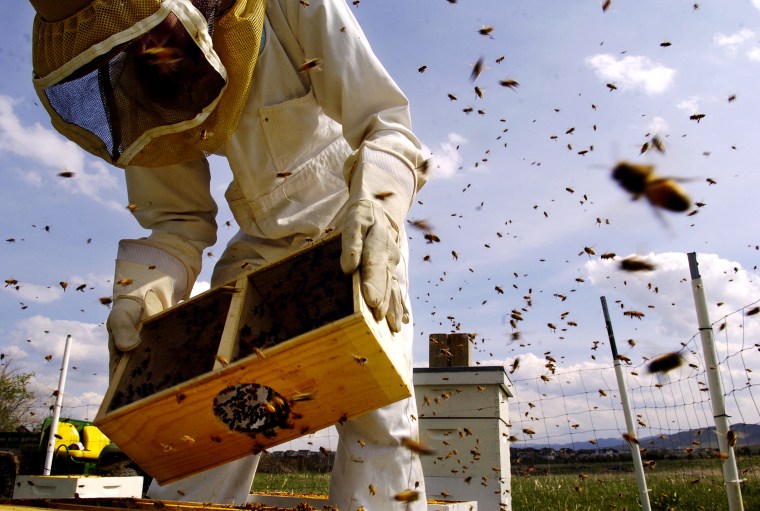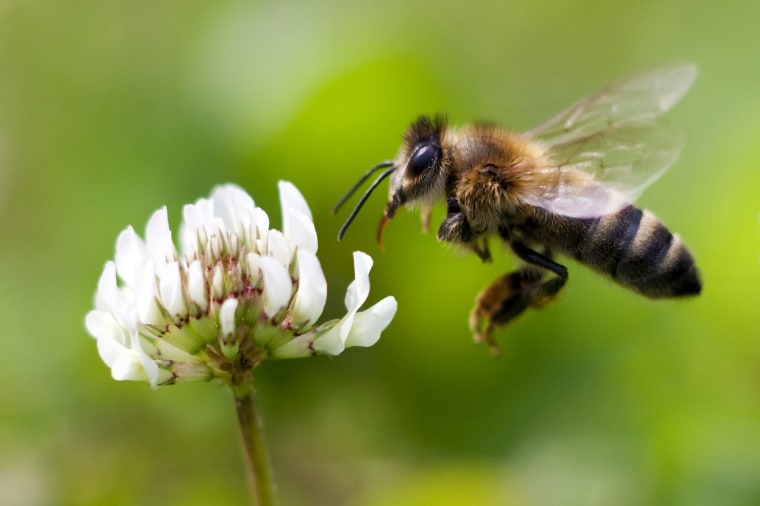The world’s bees are in big trouble — even more than you might have realized.
Last year the U.S. lost a mind-boggling 44 percent of its honeybee colonies. Certain bee species — including the rusty-patched bumblebee and Hawaiian yellow-faced bees — are on the brink of extinction. Even “Buzz the Bee” disappeared from Honey Nut Cheerios boxes earlier this month because General Mills decided removing the familiar mascot could help spotlight the problem.
A world without bees wouldn’t be pretty, and not just because we’d miss their buzzing on lazy summer afternoons. Bees play an indispensable role in pollination. About 75 percent of our major crops, including fruits, vegetables, nuts, and seeds, reproduce only with the help of bees and other pollinators.
Related: How Crickets Could Help Save the Planet
Without bees, stores would have a hard time stocking almonds, strawberries, coffee, chocolate, and other staples. And because plants and animals are so interdependent, meat and dairy products might also become scarce.
But losses would be felt beyond the food supply. Honey is used as a moisturizer in lotions, soaps, and shampoo. Oilseeds like cotton would also wither, affecting clothing and household products. And the environment would further suffer as fewer plants would be around to absorb carbon dioxide.
Given such dire prospects, environmental activists and policy makers are scrambling to find a way to mitigate the threats facing bees. It’s a hard problem to solve given that those perils are multi-faceted, include climate change and the resulting malnutrition, toxic pesticides, habitat loss, tiny parasites, and predatory insects that kill huge numbers of bees so efficiently — and brutally — that one expert says it “makes war movies look tame.”
So far no one has come up with a fix. But now scientists are on the case — and some of their possible solutions sound pretty wild.
Drones to the Rescue?
Eijiro Myiako, a researcher at Japan’s National Institute of Advanced Industrial Science and Technology, thinks there may be a technological fix. He and his colleagues have developed an insect-sized drone capable of artificially pollinating flowering plants.

Recently, Miyako’s team loosed the tiny quad-copter on a wild lily. When it bumped into the male part of the flower, it picked up pollen — the plant’s genetic material — and then transferred that pollen to the female part of another flower.
But if Miyako is hopeful that autonomous drones will one day work in the wild to help pollinate crops, other scientists aren’t so sure.
Christina Grozinger, director of the Center for Pollinator Research at Penn State University, finds the idea laughable. “That’s not going to fly,” she says. One problem is that there are more than 20,000 species of bees in the world, each of which has evolved to pollinate a particular plant or plants. Bumble bees are great at pollinating tomatoes. Honeybees are great pollinators for blueberries. And alfalfa leafcutter bees are great pollinators for, well, alfalfa.
“The idea that we can mechanize that is not really likely,” Grozinger says. Even given plenty of time to fully develop a technological fix for the loss of bees, she doesn’t think drones or another bee substitute would be capable of pollinating most plants. Nature is simply too complicated. “Nor should we want to,” she says. “If we really do get rid of the pollinators then that means that our whole ecosystem is probably in trouble.”
Bee Genes and Pesky Parasites
Dennis vanEngelsdorp, an assistant professor of entomology at the University of Maryland and project manager for Bee Informed, believes the worst threat to bees is varroa mites. This reddish-brown parasite sucks fluids from bees and delivers deadly viruses that kill off entire colonies. What’s worse, the parasite appears to be growing stronger. It takes fewer varroa mites to eliminate a colony today than it did 20 years ago because the viruses transmitted are rapidly evolving.
“We're desperate for more tools in our toolbox because the products that we once used don't work anymore,” vanEngelsdorp says.
One of those tools is being crafted at Monsanto, the St. Louis-based agro-business giant. The company has been developing a technique called RNA interference, or RNAi, which could potentially kill the troublesome parasites by disabling their genes.
Related: Robo-Bees May Bring New Fix for Pollination Problem
Already various genetically engineered crops use RNAi to silence genes in the crops themselves. In this case, Monsanto would put synthetic RNA into sugar water fed to the honeybees. Since it’s directed at a genetic sequence, it would be harmless to the bees — but lethal to the mite. The solution would attack certain proteins designed to help the mite breathe, eat, and reproduce. VanEngelsdorp, who serves on the team’s advisory board, is hopeful about the technology.
But Grozinger is skeptical. RNAi has limited effectiveness, she says. There’s a long chain of events as it moves from the bees to the mites. Even then, it will do little to save most bees.
“It is important to think about these issues holistically,” Grozinger says. “Vorroa mites are only one of the many problems facing honeybees, and they are not a problem for wild bees at all.”
Political Action and Personal Steps
If tiny drones and gene manipulation aren’t enough to save the bees, governmental action may prove helpful. Earlier this year, the Obama administration introduced a national strategy for pollinator protection and encouraged federal agencies to manage their lands in such a way that they conserved these crucial insects.
“If we really do get rid of the pollinators then that means that our whole ecosystem is probably in trouble.”
Grozinger, for one, is hopeful that the initiative will continue under the Trump administration. But she worries that proposed budgetary cuts to the Environmental Protection Agency could have a negative impact on bee populations.
Ultimately, Grozinger and other experts say the fix for the bee problem may lie with ordinary citizens. “It’s a ground-up initiative,” Grozinger says.
One thing individuals and communities can do is create special pollinator gardens, plots of land that include flowering plants that provide nectar and pollen, nesting habitat, a water source — and a lack of potentially toxic pesticides. Many pollination studies show that bees need a diverse community of flowering plants that bloom continuously from spring through summer. This will help the bees grow healthy and fight viruses.
VanEngelsdorp converted his own lawn into a meadow and found that he benefited along with insects. “It’s such a nice invigorating space,” he says. “I think people are denying themselves by just mowing the lawn.”

And it doesn’t need to be a huge effort. If just 1 percent of the nation’s lawns were converted to pollinator gardens, it would mean bees had another 50,000 square miles of hospitable space. That’s more than half of the area of all the National Parks in the U.S. combined.
VanEngelsdorp even encourages more people to become beekeepers. Not only will it help save the bees, but it will connect you to the them, he says.
“I think everyone owes it to themselves to open a colony of bees at least once in their life because it is just awe-inspiring,” he says. “You open this colony of bees. The birds are singing and the sun's behind your back. And here are these 40,000 sisters working in harmony… I just can't think of anything more inspiring than to see this society of insects do what they do.”
